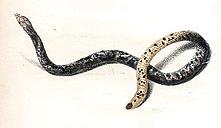| Khaire's black shieldtail | |
|---|---|
 | |
| Scientific classification | |
| Kingdom: | Animalia |
| Phylum: | Chordata |
| Clade: | Tetrapodomorpha |
| Class: | Reptilia |
| Order: | Squamata |
| Suborder: | Serpentes |
| Family: | Uropeltidae |
| Genus: | Melanophidium |
| Species: | M. khairei |
| Binomial name | |
| Melanophidium khairei Gower, Giri, Captain & Wilkinson, 2016 | |
Melanophidium khairei or Khaire's black shieldtail is a species of burrowing snake of the family Uropeltidae, endemic to India. [1] [2] [3]

Snakes are elongated, legless, carnivorous reptiles of the suborder Serpentes. Like all other squamates, snakes are ectothermic, amniote vertebrates covered in overlapping scales. Many species of snakes have skulls with several more joints than their lizard ancestors, enabling them to swallow prey much larger than their heads with their highly mobile jaws. To accommodate their narrow bodies, snakes' paired organs appear one in front of the other instead of side by side, and most have only one functional lung. Some species retain a pelvic girdle with a pair of vestigial claws on either side of the cloaca. Lizards have evolved elongate bodies without limbs or with greatly reduced limbs about twenty-five times independently via convergent evolution, leading to many lineages of legless lizards. Legless lizards resemble snakes, but several common groups of legless lizards have eyelids and external ears, which snakes lack, although this rule is not universal.
The Uropeltidae, the shieldtail or shield-tailed snakes, are a family of primitive, nonvenomous, burrowing snakes endemic to peninsular India and Sri Lanka. The name is derived from the Greek words ura ("tail") and pelte ("shield"), indicating the presence of the large keratinous shield at the tip of the tail. Seven or eight genera are recognized, depending on whether Teretrurus rhodogaster is treated in its own genus or as part of Brachyophidium. The family comprises over 50 species. These snakes are not well known in terms of their diversity, biology, and natural history.
The species was named after the herpetologist Neelimkumar Khaire. [4] [5]





